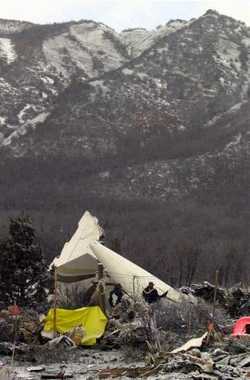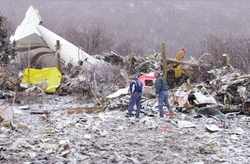Wed, Jun 12, 2002
Busted MDA, Unsent NOTAM Contributed to 18 Deaths
 The National Transportation Safety Board has
determined that the probable cause of an aviation accident in
Aspen, Colorado involving a Gulfstream III was the flight crew's
operation of the airplane below the minimum descent altitude
without visual reference to the runway.
The National Transportation Safety Board has
determined that the probable cause of an aviation accident in
Aspen, Colorado involving a Gulfstream III was the flight crew's
operation of the airplane below the minimum descent altitude
without visual reference to the runway.
Contributing to the accident was the Federal Aviation
Administration's (FAA) unclear wording of a Notice to Airmen
(NOTAM) regarding the nighttime restriction of the VOR/DME-C
approach to the airport. Also cited as contributing factors were
the inability of the flight crew to adequately see the mountain
terrain because of the darkness and weather conditions, the
pressure from the charter customers for the captain to land the
airplane, and the delayed departure of the airplane from
California, causing the flight to arrive at sunset during the
airport's nighttime landing restrictions.
On March 29, 2001, a Gulfstream III owned by Airbourne Charter,
Inc. and operated by Avjet Corporation of Burbank, California, with
15 passengers, 2 pilots and 1 flight attendant, crashed on final
approach to runway 15 at Aspen-Pitkin County Airport (ASE). The
airplane crashed into sloping terrain about 2,400 feet short of the
runway threshold. All persons aboard the aircraft died.
The Safety Board's investigation determined the following
facts:
 (1) the flight crew descended below the minimum
descent altitude even though the airplane maneuvers and comments on
the cockpit voice recorder indicated that neither pilot had
established nor maintained visual contact with the runway or its
environment;
(1) the flight crew descended below the minimum
descent altitude even though the airplane maneuvers and comments on
the cockpit voice recorder indicated that neither pilot had
established nor maintained visual contact with the runway or its
environment;
(2) the flight crew did not discuss a missed approach after
receiving a third report of a missed approach to the airport and a
report of deteriorating visibility in the direction of the approach
course; and
(3) a copy of the FAA issued NOTAM on March 20, 2001, stating
"circling not authorized at night for runway 15 at Aspen" had not
been sent to the Aspen tower.
Without knowledge of the NOTAM, the approach controller cleared the
flight crew for the VOR/DME-C instrument approach procedure.
Following the accident, the FAA became concerned about potential
pilot confusion regarding the wording of the NOTAM -- specifically,
that pilots might infer that straight-in landings to runway 15 were
authorized at night. On March 30, 2001, a revised NOTAM was issued
stating, "procedure not authorized at night."
In light of the fact that in mountainous terrain night conditions
can exist prior to sunset due to the geography and ambient lighting
conditions, the Safety Board issued an emergency Safety
Recommendation on April 15, 2002 asking the FAA to:
"Revise any restrictions and prohibitions that currently reference
or address 'night' or 'nighttime' flight operations in mountainous
terrain so that those restrictions and prohibitions account for the
entire potential period of darkness or insufficient ambient light
conditions, and establish a method to clearly communicate to flight
crews when such restrictions and prohibitions apply.
Following Tuesday's Board meeting, the Safety Board made the
following recommendation to the FAA:
 Revise 14 Code of Federal Regulations Part 135 to
require on-demand charter operations that conduct operations with
aircraft requiring two or more pilots to establish a Federal
Aviation Administration approved crew resource management training
program for their flight crews in accordance with 14 CFR Part 121,
subparts N and O.
Revise 14 Code of Federal Regulations Part 135 to
require on-demand charter operations that conduct operations with
aircraft requiring two or more pilots to establish a Federal
Aviation Administration approved crew resource management training
program for their flight crews in accordance with 14 CFR Part 121,
subparts N and O.
More News
Airport Rotating Beacon A visual NAVAID operated at many airports. At civil airports, alternating white and green flashes indicate the location of the airport. At military airports>[...]
Aero Linx: Fly for the Culture Fly For the Culture, Inc. is a 501(c)(3) non-profit organization that serves young people interested in pursuing professions in the aviation industry>[...]
Klyde Is Having Some Issues Comprehending The Fed's Priorities FMI: www.klydemorris.com>[...]
Also: Viasat-uAvionix, UL94 Fuel Investigation, AF Materiel Command, NTSB Safety Alert Norges Luftsportforbund chose Aura Aero's little 2-seater in electric trim for their next gli>[...]
Also: EP Systems' Battery, Boeing SAF, Repeat TBM 960 Order, Japan Coast Guard H225 Buy Despite nearly 100 complaints totaling millions of dollars of potential fraud, combined with>[...]
 ANN's Daily Aero-Term (04.25.24): Airport Rotating Beacon
ANN's Daily Aero-Term (04.25.24): Airport Rotating Beacon ANN's Daily Aero-Linx (04.25.24)
ANN's Daily Aero-Linx (04.25.24) Klyde Morris (04.22.24)
Klyde Morris (04.22.24) Airborne 04.24.24: INTEGRAL E, Elixir USA, M700 RVSM
Airborne 04.24.24: INTEGRAL E, Elixir USA, M700 RVSM Airborne 04.22.24: Rotor X Worsens, Airport Fees 4 FNB?, USMC Drone Pilot
Airborne 04.22.24: Rotor X Worsens, Airport Fees 4 FNB?, USMC Drone Pilot





